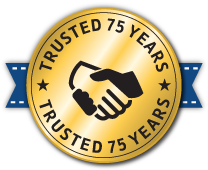You typically don’t think about your plumbing unless there’s a problem like a clogged toilet or sink drain. Individually, these issues are fairly easy to fix in just a few minutes. But, if you’re having problems with multiple drains in your home, you might have a bigger problem to address.
All of the plumbing in your home is connected to the main sewer line and if becomes clogged, the water and waste won’t be able to make its way out and will instead back up into your home. This can lead to costly repairs, or even replacement, if left unchecked over time. Understanding the causes of sewer line clogs will help you avoid this issue.
What Are the Signs of a Clogged Sewer Line?
The sooner you catch a sewer line clog, the easier it will be to remedy the situation. In order to catch the problem, however, you need to understand what the signs of a sewer line clog are. Thankfully, your home’s plumbing is great at communicating and if you just listen to it, you won’t have to guess. That said, there are a few signs of a clogged sewer line that you should be aware of:
- Multiple Slow Moving Drains – A single drain clog isn’t much to worry about. If more than one drain isn’t draining right, it’s a sign that there’s a clog further down the line, usually in the main sewer line.
- Gurgling Plumbing – If you’re noticing that your plumbing gurgles and makes a lot of noise after using the washing machine, dishwasher, or even the shower, it may be a sewer line clog.
- Bubbly, Percolating Toilet – Pay attention to the sounds your toilet makes after using your appliances, showering, or running water. Is it making a sound like a coffee pot perking? It’s likely a sewer line clog.
- Water Backing Up – If you flush your toilet and the water backs up in the sink, shower, or tub you’re looking at a potential issue with the sewer line. This is especially true in the lower levels of the home.
- Basement Drain Back Up – If you’re noticing that your basement drains are bringing water and waste into your home rather than carrying it out, there’s a problem with your main sewer line.
What Causes Sewer Line Clogs?
It’s hard to tell what’s causing a sewer line clog without a professional plumber’s inspection. However, there are some common causes of clogs that every homeowner should be aware of. While some of these issues are caused by natural forces, others are completely avoidable with a little change in behavior.
- Tree Roots – Trees send their roots out in search of water and a sewer line is a great source. If you have mature trees and an older sewer system, it’s likely that tree roots are the culprit behind a clog.
- Sewer Line Dip – Over time, pockets can form under the sewer line, causing it to dip and curve. As a result, the water and waste can’t escape and the water begins to back up into the home.
- Debris in the Line – Flushing items such as feminine hygiene products, diapers, wet wipes, and even toilet paper can cause a clog to form. These debris catch on obstructions in the pipe and can’t move.
- Foreign Objects – It’s not uncommon for a plumber to find foreign objects such as toys, towels, clothing, and other items in a clogged sewer drain.
How Do I Fix a Clogged Main Sewer Line?
The short answer is, you can’t. A clogged main sewer isn’t something that a homeowner can repair on their own. It requires a great deal of experience in sewer cleaning, heavy equipment, and a professional plumber’s license.
The best thing to do is to turn the water off completely to avoid flushing any toilets or running any water. Then, contact us at S.O.S Drain & Sewer Service to evaluate the problem. They’ll quickly locate the clog, develop a plan to remove it, and take care of all the details for you.



